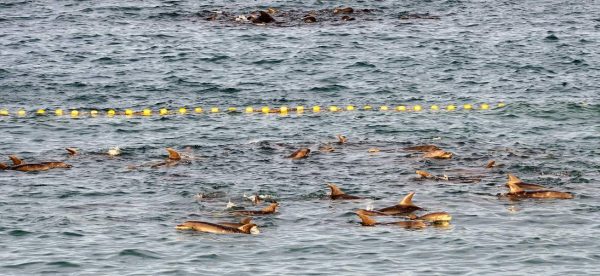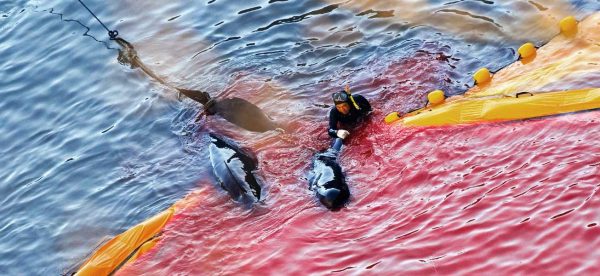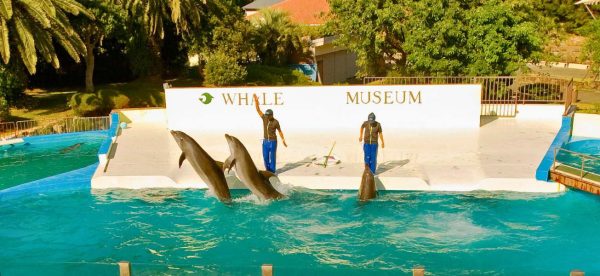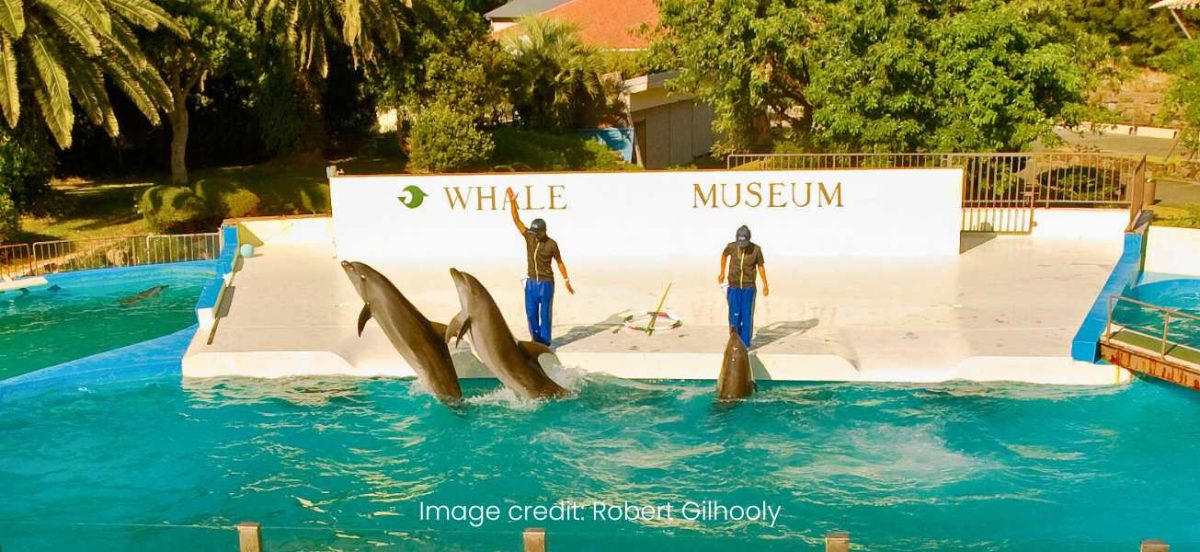Our investigator in Japan recently had the opportunity to interview a dolphin trainer who had worked at a facility in Taiji Town where dolphins are kept. Interviewed on condition of anonymity, the trainer* revealed how the notorious dolphin hunts in the town were only part of a much wider-reaching tragedy, and that dolphin deaths are common throughout the entire scope of the cetacean trade and captivity industry in Japan.
*For identity protection purposes, the trainer will be referred to by the pseudonym “Masumi” or by using “they,” or “their.”
From a young age, Masumi dreamed of becoming a dolphin trainer, and during higher education majored in marine science and spent summer vacations studying and working voluntarily at facilities where dolphins were kept. When the opportunity opened up to work at such a facility after graduation, Masumi was over the moon, saying “it was like a dream come true.”
The facility where Masumi was employed was in Taiji Town, which is infamous for its dolphin hunts and is today the only place in Japan that conducts them. Within months that dream had turned into a nightmare.
During the summer months, Masumi was charged with training the facility’s dolphins, but in the off season was tasked with selecting dolphins from the hunts that would go into captivity.
Ultimately the small group of men who conduct the hunts radio around aquariums and marine parks from their boats out at sea to see if there are any requests or orders. But according to Masumi they are already well versed in the kind of catch that facilities such as aquariums most desire: young, preferably female Bottlenose dolphins.
Once a pod of dolphins is driven into a small secluded cove in Taiji’s Hakejiri Bay, the hunters dive into the waters to perform an initial triage according to these criteria, sifting out larger, older dolphins. Unless a specific request has been made, many males will also be segregated as aquariums tend to see them as more likely to cause trouble, especially during the mating season. Those sifted out, Masumi says, will ultimately be slaughtered for their meat.

It was then the trainer’s job to determine which dolphins should be selected for captivity, with the Taiji aquariums always getting first dibs. In addition to the hunters and trainer the only other people present during this sorting process in the cove were staff from aquariums who would occasionally visit to see and choose the dolphins they wanted (usually, however, aquariums would leave that selection to local Taiji trainers/suppliers).
While Bottlenose dolphins were by and large the preferred dolphin species, there was talk among both hunters and trainers about the falling numbers of available catch. The hunters themselves had been predicting this for some years, Masumi said, adding it was suggested that overfishing could be a reason.
“The number of pods and the numbers in the pods were already decreasing and they (the hunters) often said it would not be long until they wouldn’t be able to catch anymore,” the trainer said, adding a similar problem in Futo in the nearby Shizuoka Prefecture had resulted in zero catches of dolphins there for some years. That’s ample evidence, Masumi said, that “the overall number of dolphins in the wild is decreasing.”
Unfazed by the situation with the Bottlenose dolphins, the hunters began targeting alternative species, including Pantropical Spotted dolphins, Melon-headed whales, and Rough-toothed dolphins, species that Masumi said have been completely and actively ignored by fishermen because of their nervousness and inability to relate to humans, which made them unattractive to clients.
It was also acknowledged by some that the hunt method was the root cause of the decline in Bottlenose dolphin numbers. “When the fishermen targeted Bottlenose dolphins they’d take an entire pod in one fell swoop,” Masumi said, adding that there was a time when pods caught could consist of 200 or more dolphins. Then they would be sorted into those for captivity and those for meat.
“If you employ this kind of catch style it’s inevitable that numbers will eventually decline. This is what was being said would happen years ago. And in fact, that’s what has happened. With each passing year fewer and fewer Bottlenose have been caught.”
The new targets, such as Pantropical Spotted dolphins, were not chosen due to any similarities to their Bottlenose cousins. In fact, while the latter species is well known for its overall congeniality, the former is notoriously nervous, finding it difficult to adapt to human contact, said Masumi, who also has a wealth of experience with dolphins in the wild.
But while the trainer attempted to explain this to the hunters, it fell on deaf ears and their treatment of the animals was far from appropriate. On one occasion they pressured Masumi to quickly transport 10 Pantropical Spotted dolphins to a facility, which was also part of the trainer’s sphere of responsibility. According to Masumi the reason for the urgency was the fishermen needed to transport other dolphins to the market, where they would be processed for meat. Already stressed by the hunt and selection procedure, the dolphins became even more unsettled as the trainer felt obliged to respond to the agitated fishermen’s demands.
In fact, the dolphins were in such an anxious state that only two of the 10 survived the short 15-minute boat trip to the facility’s pens. “They died of shock,” Masumi said.
While one Pantropical Spotted dolphin would fetch under 10,000 yen when sold for meat, it would be worth several hundreds of thousands of yen if sold into captivity.
The hunters, who are all members of the Isana no Kai — a cliquey cooperative of a few dozen men operating a fleet of 12 fishing boats — clearly valued dolphins more for aquarium use as a source of income than for meat. But because they treated the dolphins in such a manner, the facility’s management “issued them with a very strong warning,” the trainer said, adding that subsequently the hunters became more careful in their treatment of Pantropical Spotted dolphins.
Dolphin deaths are not unusual during the Taiji hunts. Dolphins suffer “extreme panic” caused by banging metal pipes underwater to confuse their sensitive sonar and herding them from open waters into the Taiji cove. Handlers are forbidden from administering any kind of medication to calm the animals, and so on, because it would render any medicated dolphins unusable for meat consumption purposes, the trainer said.
But this is just the start. It is also not unusual for pregnant dolphins to have miscarriages and stillbirths. The baby seen and recorded on film by our investigator floating belly up in the bloody cove was probably an example of this, according to the trainer.
“There are many occasions where pregnant dolphins have stillbirths right there in the cove, due to stress, I think. I have heard that these fatalities are not included in the catch data, even though they should be.”
Even when such misfortune is avoided, there are occasions where pregnant mothers lose their offspring shortly after being captured due to miscarriages or stillbirths, according to Masumi. And then there are occasions where the birth goes ahead safely, but the mother dies, the trainer added.

There are many other examples of dolphin deaths during transportation to aquariums and other facilities, Masumi said. The trainer had some involvement with preparing dolphins destined for overseas trade, mostly to China. The animals are first placed into narrow containers filled with water and loaded onto small trucks, which transport them during the night to Kansai International Airport, about 3-4 hours away. During the entire trip handlers are supposed to replenish the water, as it quickly becomes soiled and unsanitary.
And just at the time when they empty the tanks to change the water there are occasions when the dolphins panic and die of shock. This is particularly true of Pantropical Spotted dolphins, but it is also true of other species, even Bottlenose dolphins, the trainer said.
“So the hunts themselves are certainly not the only threat to dolphins, and deaths occur across the entire operation, including, of course, the many that die in captivity.”
An occasional cause of dolphin deaths in this instance is force-feeding, which is commonplace when dolphins first enter captivity, the trainer said. Plastic pollution in the aquarium tanks is another life-threatening hazzard, while natural disasters such as earthquakes and typhoons, which are frequent in Japan, can result in dolphins getting caught up in netting, or being relocated to other facilities with different environments, resulting in death.
Data collated by the Japanese animal rights group PEACE indicate there were 51 deaths at Taiji’s aquariums and pens in 2021. Among those were the deaths of 22 dolphins in one month at a facility called Dolphin Resort, which the trainer speculates was probably the result of an outbreak of disease. The trainer has heard that a similar situation arose at the Yokohama Hakkeijima Sea Paradise, where the spread of swine fever had wiped out most of the dolphins there.
“I heard that one of the staff there kept a miniature pig and probably it was spread from that. Like other infectious diseases, swine fever can stir up a hornet’s nest, especially at aquariums with cramped pools.”
Indeed, Dolphin Resort in Taiji would fit that bill, and Masumi includes the facility in Japan’s “worst three” in terms of conditions and level of care (one of the other two, Inubosaki, was so poor that it recently closed, while the other in Tokyo’s Shinagawa Ward is closing the doors of its dolphinarium next year due to its cramped conditions and the global shift in public sentiment toward keeping dolphins in captivity).
It was this apparent disregard for animal welfare, which seemed to go against the very principle of a trainer’s duty of care, that was the core reason for Masumi eventually quitting, and speaking to Action for Dolphins about their experiences.
“I had seen footage of the hunts, for example, and I knew about what went on in the sorting and the hardships dolphins faced and how cruel all of it was, but I was more interested in realising my dream (to become a trainer). But when it came to actually going there and doing it and seeing all of this with my own eyes, it was too much. I simply couldn’t bear it.”
Eventually acute depression triggered by the situation, and the poor working environment that demanded long hours for low pay and no overtime compensation, led to Masumi leaving.
Another reason was the belief by some in the aquarium industry that they were protecting or saving dolphins from being slaughtered and thus extending their lives. “I didn’t think that way. On the contrary, I thought ‘why do they do something that is so terrible and pitiable.’ ”
Masumi wasn’t the only person who harboured these beliefs, which accounts, perhaps, for the high turnover of staff, the trainer said. “One of my workmates made the comment that what they were doing was nothing short of abduction and confinement and I thought ‘that’s exactly right.’ At around that time there was some action in Taiji by activists and I remember thinking ‘well if this is the kind of custody being provided, it’s only right they’d protest.’ After that it was impossible to carry on.”
Masumi was also perturbed by a “duplicitous understanding” between the Taiji hunters and aquariums to ensure the former’s business was never threatened. To talk about breeding was almost taboo.
“I heard that a staffer from an aquarium who took part in the sorting in Taiji was interviewed by a TV station, and during that interview that staffer spoke about having high hopes for breeding dolphins at their aquarium. When the Taiji fishermen heard this they complained, saying: ‘We are going out of our way to get these dolphins for you, so why do you say something like that? We are hunting these dolphins for your benefit.’ I was shocked when I heard this. They are basically saying: ‘Don’t breed. If you do, we will lose our jobs.”
“The situation with aquariums in Japan is they see wild caught as a more convenient option compared with breeding — that dolphins from the wild can be taken at any time. They can easily be bought from Taiji whenever needed. The mentality was, ‘If a dolphin dies we can quickly replace it.'”

Even those few places that do conduct breeding programs say they still need to take from the wild because of inbreeding problems and other reasons that “sound like excuses” and that often result from “misinformation” spread by certain people in Taiji and elsewhere, the trainer said.
Masumi has found ways to enjoy observing dolphins in the wild, but retains a deep concern about misinformation regarding aquariums and cetacean hunting that is dished out by interested parties and echoed by a complicit media. Recent coverage of the deaths of multiple dolphins in quick succession at a public aquarium in Niigata was given some attention in the local media, but the incidents were downplayed despite an independent body finding significant problems in the facility’s design. It was also made to sound like a rare occurrence, which filled Masumi with a deep sense of anger.
“I remember thinking at the time ‘That’s not a rare occurrence at all.’ The truth is that this kind of thing happens at many aquariums. People are just unaware.”
To keep the momentum going to stop the Taiji dolphin hunts please sign our petition.
